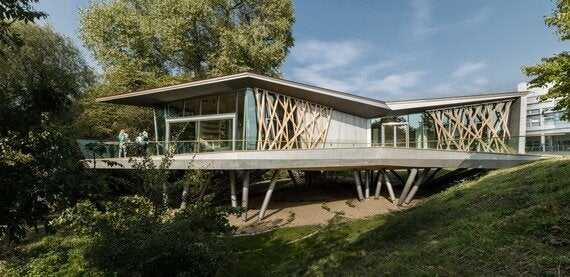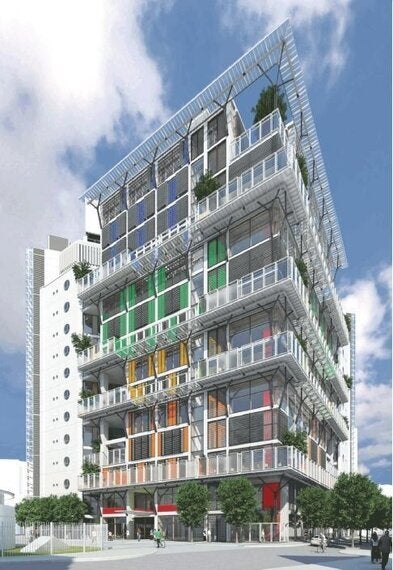Being on a cancer ward for the first time can feel a lot like a torture camp. There are screams in the night from neighbouring rooms, sounds of retching; there are unfamiliar figures arriving with sharp instruments and toxic substances.
But it was the surroundings which really made me feel like a detainee in a cell when I was diagnosed with leukaemia last year. With my immune system on the verge of self-destruction, I was told I would need to be kept in isolation for my own protection. I understood this, but being trapped inside the same four walls for months on end was like being in prison - especially as my only view from the window was a brick wall opposite. (A window which - like in a prison - was permanently jammed shut, to protect patients from airborne bacteria).
Most hospitals and care centres are demoralising enough at the best of times, even if you're only coming in for a routine check-up. Monolithic concrete blocks which held a certain brutalist charm in the 1960s have since been sullied by layers of dirt and pigeon excrement. They say it's what's on the inside that counts - in which case, you've got waiting areas with hard plastic seating and no windows, artificially lit and ventilated - all conspiring to create the grim coldness of an interrogation room.
But who's complaining about architecture in a time of economic austerity? With frontline services constantly being cut, do we really have the luxury of worrying about interior design? The medical treatment I received - and continue to receive - at my hospital has saved my life. Does it really matter that the prison next door (Wormwood Scrubs) probably has better views?
Actually, a mounting body of evidence would seem to show that it does. Obviously it's cheering to have a scenic view, but research suggests it could have tangible health benefits. In particular, a study conducted by Roger Ulrich, of the Center for Healthcare Building Research at Chalmers University of Technology in Sweden, found that patients with a view of trees tend to recover faster after surgery, require less pain medication and have fewer post-operative complications than those with a view of a brick wall.
'I used to think architecture didn't matter at all,' Laura Lee tells me. A cancer nurse for many years, she's now CEO of Maggie's, the charity responsible for a growing number of eclectic creations which have sprung up around UK cancer hospitals over the last 18 years. The Maggie's centres have trained staff who greet you with a cup of tea and a chat; they offer free classes like yoga and tai chi, as well as advice on financial support and nutrition. But what marks them out from other care centres is their design; these places are architectural showpieces, the work of big names like Zaha Hadid, Frank Gehry and Richard Rogers. The charity was named after its founder, Maggie Keswick Jencks, who found herself disheartened by the usual NHS surroundings after a terminal cancer diagnosis.
Although Jencks did not live to see the first of the centres, her former friend and nurse Lee is now fastidious about bringing the Maggie's vision into being. Despite being at the helm of one of the UK's most prominent cancer support charities, she still makes time for the little details - choosing the new rugs and chairs in each centre - because it's the small touches which make a difference, she says. 'It's the imperfections - you don't want everything to match. NHS waiting rooms are very uniform, which creates a regimented atmosphere. You don't have permission to talk to people.'
We are at the opening of a new Maggie's centre in Oxford, a treehouse structure designed by architects Wilkinson & Eyre. The weather outside is dismal; grey skies and heavy rain, but inside the sunshine-yellow walls immediately lift the spirits, and the playful features - a large triangular table, relief artworks dotted around - are an instant talking point, getting visitors chatting as soon as they come in.

The new centre in Oxford is based around a treehouse concept. Photograph: Wilkinson Eyre Architects
An old vintage-style kettle adds to the domestic cosiness, and you're struck by the odd sense of being both inside and outside at the same time. While you're sheltered from the cold and the clinical realities of illness at the Churchill Hospital next door, there are glass walls overlooking clusters of trees, so you feel as though you're walking in the midst of a forest, and windows in the floor expose the earth underneath.
Realistically, the NHS could never seek to replicate this kind of design innovation, but it ought to learn from the Maggie's philosophy of welcoming spaces, with views of nature. Hospitals are where we are born, they are where most of us will die. They are where we spend anxious hours drinking coffee in waiting rooms. And with one in three of us set to develop cancer in our lifetimes, they are becoming an increasingly important part of our lives.
We need spaces where we can recover and where we can die with dignity. NHS staff, who make up the largest workforce in the country, deserve a workplace where they can give the best level of care; at the moment, many are struggling in environments with poor acoustic design and noise levels which have apparently doubled since the 1972.
Thankfully it seems as though change is on the way; a new cancer centre is due to open to patients at Guy's hospital in London next year, designed in part by Richard Rogers' firm, and patients have been involved in the process, giving their views about traditional radiotherapy suites in basement areas. 'They told us they felt as if they were going into an airless dungeon for their treatment and their plea was for the radiotherapy treatment area to be above ground in an area with natural light,' says Alastair Gourlay, Programme Director for the new Cancer Centre. 'And that is exactly what we have done.'
Let's hope it's the beginning of the end for cancer wards which feel like prisons.

How the new cancer centre at Guy's hospital is expected to look. Image: Guy's and St Thomas' NHS Foundation Trust